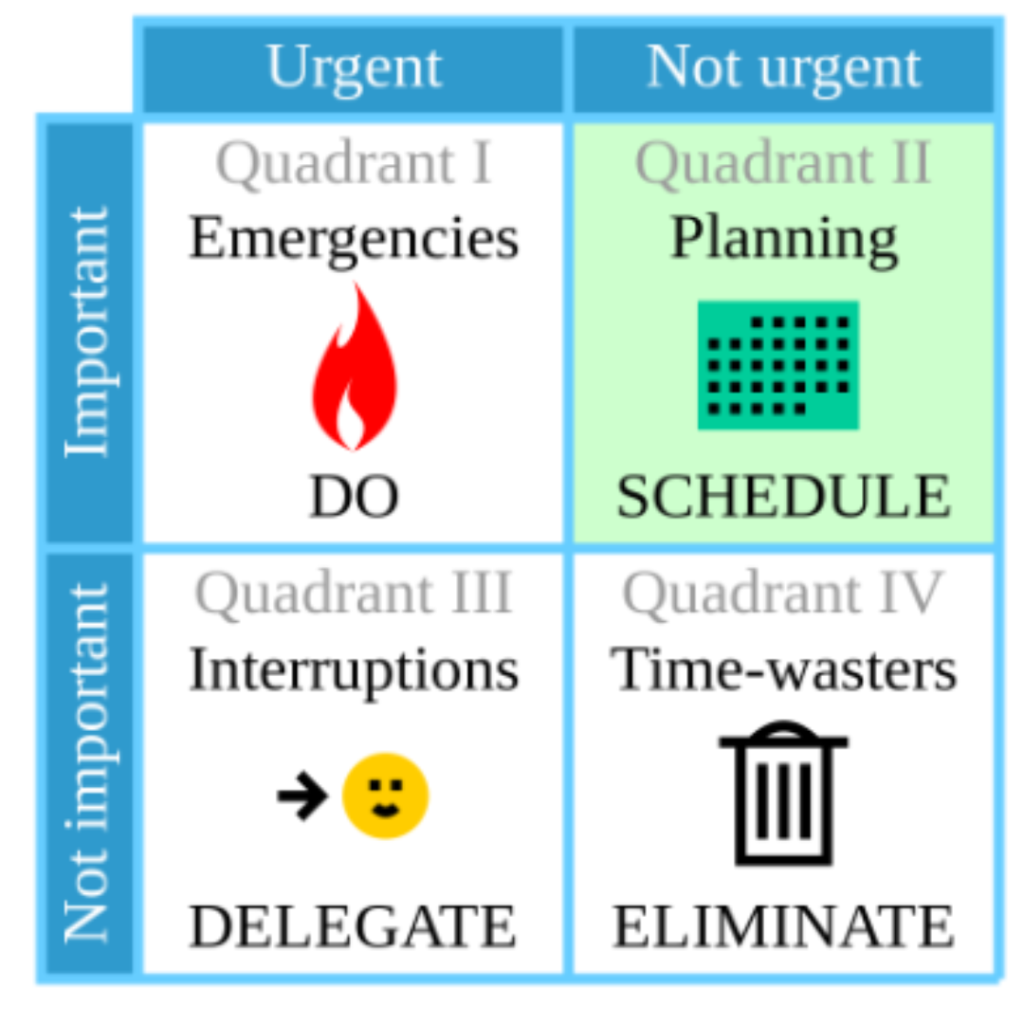
Does this sound like you? You always feel busy. You have a ton on your plate. You work incredibly hard every day. However, at the end of the day or the week, you feel like you’re not getting enough done. You’re giving it your all, but you still don’t manage to get to the things that you know matter most. If so, you might spend a lot of your time feeling anxious about deadlines and guilty about the work you’re not able to get to.
But fear not! If you fit the description above, the Eisenhower matrix might just be the perfect solution for you.
With only so much time and energy per day, the solution can’t always be simply “to get faster.” At a certain point, you won’t be able to get faster or get more things done. The big “aha” here is that productivity is not just about speed, it’s about where you direct your energy and focus. You need to learn to be a ruthless prioritizer.
In comes the Eisenhower matrix.
The Eisenhower Matrix: Simplify How You Prioritize Your Work
“What is important is seldom urgent and what is urgent is seldom important.”
—Dwight Eisenhower, 34th President of the United States
Based on the approach of the 34th president of the United States, Dwight D. Eisenhower, the Eisenhower matrix is a simple four-box model to help you sort your incoming work into one of four categories.
- Urgent and important: Do it now.
- Not urgent and important: Schedule it.
- Not important and urgent: Delegate it, batch it, or delay it.
- Not important and not urgent: Delete it.
 How to Determine What is Urgent and What is Important
How to Determine What is Urgent and What is Important
Before we get into more detail on each of the quadrants, there’s an important distinction to understand. To use the Eisenhower matrix well, you need to become a master at determining what is and isn’t important and what is and isn’t urgent. Here’s a quick breakdown of each:
Urgent tasks are tasks that are timebound with serious consequences if you don’t get to it within that timeframe. Putting these tasks off will cause you stress. Examples include:
- A team project with a strict deadline
- A customer problem that you need to fix
- Your kid is sick and needs you to pick her up from school
Important tasks are not necessarily immediately timebound, but they are important to your long-term goals. These tasks are critical to schedule out so that you can make consistent progress. Examples include:
- A long-term project
- Upkeep, organization, and system maintenance
- Getting exercise
With that in mind, let’s take a closer look at each of the four quadrants of the model:
Quadrant 1: Urgent and Important – Do it Now
This is the quadrant for your tasks that are urgent and important. That means it simultaneously impacts your long-term goals and is immediately timebound. The best way to test whether something belongs here is to think about the things that are the most actively stressful to you. If a task is on your mind causing you anxiety, there’s a good chance it belongs in this quadrant.
Quadrant 2: Not Urgent and Important – Schedule it
This is for the non-urgent yet still important tasks. For people who are busy and face a lot of urgent tasks, these tasks can easily slip through the cracks at a detriment to your long-term goals and your career. To solve for that problem is to schedule these tasks out to ensure you set aside the focused time and energy you need. For example, this might include networking, upskilling, or even exercise.
Quadrant 3: Urgent and Not Important – Delegate it or Batch it
This is for the tasks that you need to get done urgently, but they aren’t necessarily important. In other words, the timing matters but the tasks aren’t relevant to your longer-term goals. You should strive to delegate these tasks to your direct reports. If you don’t have anyone to delegate to, then you should batch these tasks. In other words, instead of letting the tyranny of the urgent distract you from your more important tasks, set aside a block of time to devote to all of your quadrant 3 tasks.
Quadrant 4: Not important and Not Urgent – Delete it, Bin it, Cancel it
Once you’ve placed your tasks into each of the first three quadrants, the tasks that remain are the ones you should delete. Since these tasks don’t help you progress toward your goals and they aren’t urgent, you’re better off clearing them out to make space for the tasks that are urgent and important.
Five of the Most Common Mistakes with the Eisenhower Matrix
The quadrants make everything seem so simple, but it’s possible to use the Eisenhower matrix and still struggle with productivity. Often that’s because of the following five most common pitfalls, which you should learn and avoid:
Mistake #1: Labeling too many things as “important”
Perhaps the most pervasive struggle that people face is that they set too many tasks as important. To avoid this mistake, ask yourself: “What is the serious and significant negative consequence if I don’t do this task?” If there is a significant negative consequence, it’s important. Otherwise, you might be placing too much importance on it.
Mistake #2: “Labeling the little things as ‘not urgent’ when they do need to get done on a short timeline
The other mistake is to mess up your timing. Something like responding to emails might not be urgent, but you can’t just leave your emails unread for days. You probably need to keep a pulse on your email communications daily if not a few times per day or more. When that’s the case, you have to be sure to schedule it. Otherwise you may miss the natural, expected pulse of check-ins and communication.
Mistake #3: Not deleting nearly enough tasks
Many people struggle with quadrant four. They can’t let anything go. A good rule of thumb is to consider that the things that are truly important will find a way to creep back onto your list. The other way of thinking about this is to say, if this is truly an important task, you wouldn’t be on the fence about it. It’s always better to err on the side of overdeleting versus under-deleting and leaving no room for your most important tasks.
Mistake #4: All or too much of your time feels like it’s spent on both the urgent and important.
If you’re facing this problem, there are usually two main solutions. The first is that the little urgent things are stealing your attention and disrupting you from getting to the long-term important things. If that’s the case, get more serious about batching all the little tasks into a power hour (or two). The second possibility is that you may actually have too many tasks that are both important and urgent. In that case, you are likely overloaded and need to speak with your supervisor about adjusting your workload.
Mistake #5: You aren’t clear on your goals, which makes it difficult to categorize the importance level of each task.
It’s hard to guage importance and decide what to cut if you aren’t sure what goals and outcomes you’re working toward. If you’re struggling with this, try to ask yourself what you’re working toward and why. With this in mind, go back to the matrix and try to categorize your work again. The importance-level should be much more clear.
Slow Down, Work Smarter, Feel Better
The Eisenhower method is by no means a perfect tool for organization and productivity, but it’s a great way to slow yourself down, take a closer look at what you might be able to eliminate, and move toward your goals with more clarity and efficiency.
Sources to continue learning about the Eisenhower Matrix:
- Great podcast breaking down each quadrant: https://open.spotify.com/episode/5k4fsupNhzMXEW481GDSOU?si=1pKeomJkQMOtDRFG4E3xTg
- James Clear wrote a nice piece on using the matrix: https://jamesclear.com/eisenhower-box
- HBR write-up about using this matrix with your team: https://hbr.org/2020/08/conquer-your-to-do-list-with-this-simple-hack


 How to Determine What is Urgent and What is Important
How to Determine What is Urgent and What is Important 


